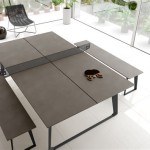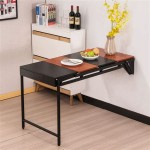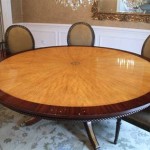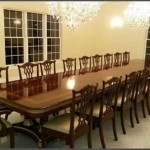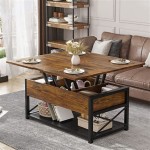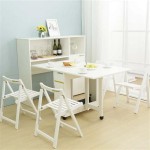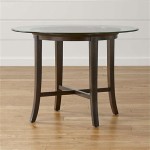Mid-Century Modern Small Dining Tables: Style and Functionality
The mid-century modern aesthetic, flourishing from the mid-1940s to the late 1960s, continues to exert a significant influence on contemporary interior design. Its emphasis on clean lines, organic shapes, and functional elegance makes it particularly well-suited for modern living spaces, including smaller apartments and homes. Among the most iconic pieces of mid-century modern furniture is the dining table, and specifically, the small dining table, designed to maximize space without sacrificing style. This article explores the key features, influential designers, and practical considerations for incorporating a small mid-century modern dining table into your home.
Key Characteristics of Mid-Century Modern Dining Tables
Mid-century modern dining tables are characterized by several distinct features that contribute to their enduring appeal. These features include a focus on minimalism, a preference for natural materials, and an emphasis on functionality.
Firstly, minimalism is a defining principle. Designers favored simple, uncluttered forms, eschewing elaborate ornamentation or excessive detailing. The purpose was to create furniture that was both aesthetically pleasing and highly functional, avoiding unnecessary visual distraction. The tables are often characterized by their clean lines and geometric shapes, reflecting the modernist movement's rejection of historical styles.
Secondly, the use of natural materials is prevalent. Wood, particularly teak, walnut, and oak, are commonly employed for the table tops and legs. These materials are chosen for their warmth, durability, and natural beauty. Wood grains are often highlighted, rather than concealed, to accentuate the natural character of the material. In some cases, wood is paired with other materials, such as metal or glass, to create a more contemporary look.
Thirdly, functionality is paramount. Mid-century modern dining tables are designed to be practical and efficient. Small dining tables, in particular, are often designed with space-saving features. These might include drop-leaf extensions, which allow the table to be expanded when needed and folded away when not in use. Simplicity of form contributes to ease of use and maintenance. The tables are generally designed to be easy to clean and care for, reflecting a practical approach to everyday living.
Influential Designers and Iconic Designs
Several designers played a pivotal role in shaping the mid-century modern aesthetic and creating iconic dining table designs. Their work continues to inspire contemporary furniture design and remains highly sought after by collectors and enthusiasts.
One prominent figure is Charles and Ray Eames. Their designs, known for their innovative use of materials and ergonomic considerations, revolutionized the furniture industry. While not exclusively focused on dining tables, their molded plywood chairs became a staple in mid-century modern dining rooms. Their influence extended to table design as well, with their emphasis on simple, functional forms. The Eames Molded Plastic Dining Table with Eiffel Base reflected the era's interest in combining industrial materials with elegant design.
Another influential designer is Arne Jacobsen. Known for his contributions to Danish modern design, Jacobsen created elegant and functional furniture that reflected the Scandinavian aesthetic. His Ant Chair, with its simple and stackable design, was often paired with dining tables. His emphasis on clean lines and organic shapes contributed to the overall aesthetic of mid-century modern dining spaces.
George Nelson also made a significant impact on mid-century modern design. Nelson's work, characterized by its playful and innovative approach, often incorporated bold colors and geometric patterns. His designs for Herman Miller, including the Nelson Pedestal Table, are considered classics of the era. His focus on modularity and adaptability made his designs well-suited for modern living spaces.
These designers, among others, established the key principles of mid-century modern design and created iconic pieces that continue to be admired and emulated today. Their emphasis on functionality, simplicity, and natural materials has had a lasting impact on the furniture industry.
Practical Considerations for Choosing a Small Mid-Century Modern Dining Table
Selecting a small mid-century modern dining table requires careful consideration of several practical factors. These include the size of the space, the number of people who will typically use the table, the overall style of the room, and the budget.
Firstly, assessing the size of the space is essential. Before purchasing a dining table, measure the available area to ensure that the table will fit comfortably. Consider the space needed to pull out chairs and move around the table. A small dining table should not overwhelm the room or impede traffic flow. Consider the shape of the table in relation to the room's dimensions. Round or oval tables can be a good choice for smaller spaces, as they allow for more flexibility in seating arrangements.
Secondly, consider the number of people who will typically use the table. A small dining table is generally suitable for two to four people. If you frequently entertain guests, consider a table with a drop-leaf or extension feature that can accommodate additional diners. Ensure that each person will have adequate space to eat comfortably. Remember to account for elbow room when determining the appropriate size of the table.
Thirdly, consider the overall style of the room. The dining table should complement the existing furniture and décor. Choose a table that reflects the mid-century modern aesthetic, with clean lines, natural materials, and a minimalist design. Consider the color and finish of the table in relation to the other elements in the room. A walnut table, for instance, might pair well with other natural wood tones and earthy colors.
Fourthly, establish a budget. Mid-century modern dining tables can range in price from affordable reproductions to expensive vintage pieces. Determine how much you are willing to spend before beginning your search. Consider the quality of the materials and construction when evaluating the cost of a table. Investing in a well-made table can ensure its longevity and durability.
Materials and Finishes: Authenticity and Durability
The materials and finishes used in a mid-century modern dining table contribute significantly to its overall aesthetic appeal and longevity. Understanding the common materials and their characteristics is crucial for making an informed purchase.
As mentioned previously, wood is a primary material. Teak, walnut, and oak are favored for their rich color, durability, and inherent grain patterns. Teak is particularly valued for its resistance to moisture, making it a suitable choice for dining tables that may be exposed to spills. Walnut offers a darker, more sophisticated look, while oak provides a lighter, more versatile option. The type of wood selected impacts the overall tone of the dining area.
Metal is another common material, often used for the table legs or supporting structures. Chrome and brushed steel were popular choices during the mid-century modern era, offering a sleek and contemporary contrast to the warmth of the wood. Metal legs often feature tapered designs, further emphasizing the clean lines of the table. The quality of the metal finish is important for preventing rust and maintaining a polished appearance.
The finish applied to the wood surfaces is also an important consideration. A clear lacquer or varnish is often used to protect the wood and enhance its natural grain. A matte finish is often preferred for a more subtle and understated look, while a gloss finish provides a more polished appearance. The finish should be durable and resistant to scratches and stains. Regular cleaning and maintenance will help to preserve the finish and extend the life of the table.
Beyond the primary materials, some mid-century modern dining tables incorporate glass or laminate surfaces. Glass tabletops offer a transparent and contemporary look, while laminate provides a durable and affordable alternative to wood. When selecting a glass tabletop, ensure that it is tempered for safety and durability. Laminate surfaces should be scratch-resistant and easy to clean.
Integrating a Small Mid-Century Modern Dining Table into Your Decor
Successfully integrating a small mid-century modern dining table into your home decor requires careful consideration of the surrounding elements. The table should complement the existing furniture, lighting, and accessories to create a cohesive and harmonious space.
Start by selecting chairs that complement the style and size of the table. Mid-century modern dining chairs, such as the Eames molded plastic chairs or the Arne Jacobsen Ant chairs, are excellent choices. Consider the height of the chairs in relation to the table to ensure a comfortable dining experience. Upholstered chairs can add warmth and texture to the space. Color contrast can add visual interest to the seating arrangement.
Lighting plays a crucial role in creating ambiance in the dining area. A mid-century modern pendant light or chandelier suspended above the table can serve as a focal point. Choose a light fixture that complements the style and scale of the table. Consider the color temperature of the light bulbs to create the desired mood. Dimmable lights can provide flexibility for different occasions. A statement light fixture enhances the overall aesthetics.
Adding accessories can help to personalize the dining area and enhance its overall appeal. A simple vase of flowers or a sculptural centerpiece can add a touch of elegance. Consider using a tablecloth or runner to protect the table surface and add visual interest. Choose accessories that reflect the mid-century modern aesthetic, such as geometric patterns or abstract art. Plants are also a great addition.
Rugs can also help to define the dining area and create a more inviting space. Choose a rug that is large enough to accommodate all the chairs when they are pulled out from the table. A rug with a geometric pattern or a bold color can add visual interest to the room. Ensure that the rug is made of a durable and easy-to-clean material.

Rectangle Wood Small Dining Table Unique Narrow Space Saver Dine Mid Century Modern Minimalist Home Kitchen Furniture Etsy

Ashcroft Furniture Co Aria 47 In Mid Century Modern Style Solid Wood Walnut Brown Frame And Top Rectangular Dining Table Seats 4 Dt Abbot S Wlnt

Square Oak Wood Dining Table Mid Century Modern Rustic Dine Small 2 Person Space Saving Breakfast Kitchen Furniture Etsy

Walker Edison 59 Mid Century Wood Tapered Leg Dining Table Walnut

Trestle Mid Century Dining Collection West Elm

Mid Century Modern Dining Table Wood Stone Top Design 0b90zf01

Mid Century Extendable Dining Table 60 80 Acorn West Elm

Mid Century Modern Dining Table With Trestle Base
Mid Century Expandable Dining Table Drew Jonathan

Solid Wood Rectangle Small Space Kitchen And Dining Table Brown Walnut The Vermont Country


